You are using an out of date browser. It may not display this or other websites correctly.
You should upgrade or use an alternative browser.
You should upgrade or use an alternative browser.
Idolomantis Consolidated
- Thread starter sporeworld
- Start date

Help Support Mantidforum:
This site may earn a commission from merchant affiliate
links, including eBay, Amazon, and others.
Precarious
Well-known member
There are members way more qualified to answer this question but these are my observations.hey guys. i just noticed that there seems to be two strains of idolos in culture. one has a blue or black base to the thorax in the nymph phase while the other has a green base. has any one else noticed this?
There is some slight variation between nymphs depending on conditions and natural variance.
For instance, this is an L3 nymphs I got from Nick that got his original stock from the same source I got mine originally, yet they turned out somewhat different in coloration. Take note that this nymph is nearly white with streaks of pink with black marks on the headpiece.
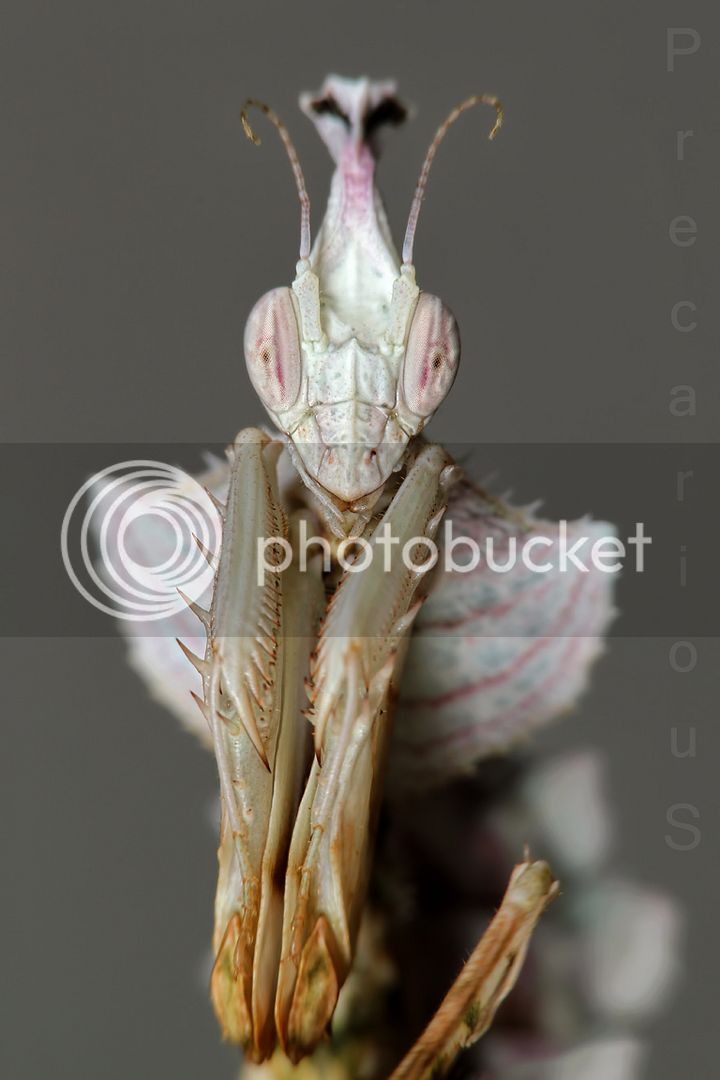
Coloration also varies with each molt and changes depending on how long after molt the photo was taken. There is a gradual change in shade from one molt to the next. The most noticeable, of course, is after the final molt.
This is an adult female days after final molt...
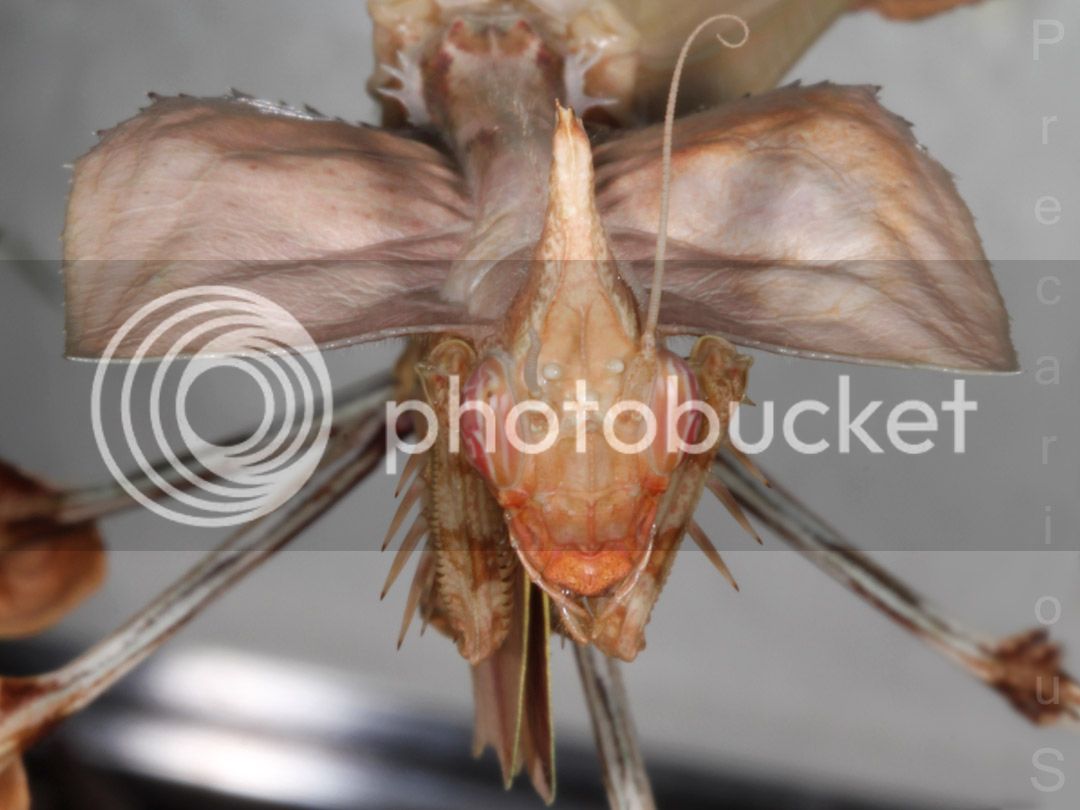
And this female had a lot more pink than others and held onto it pretty far into adulthood...
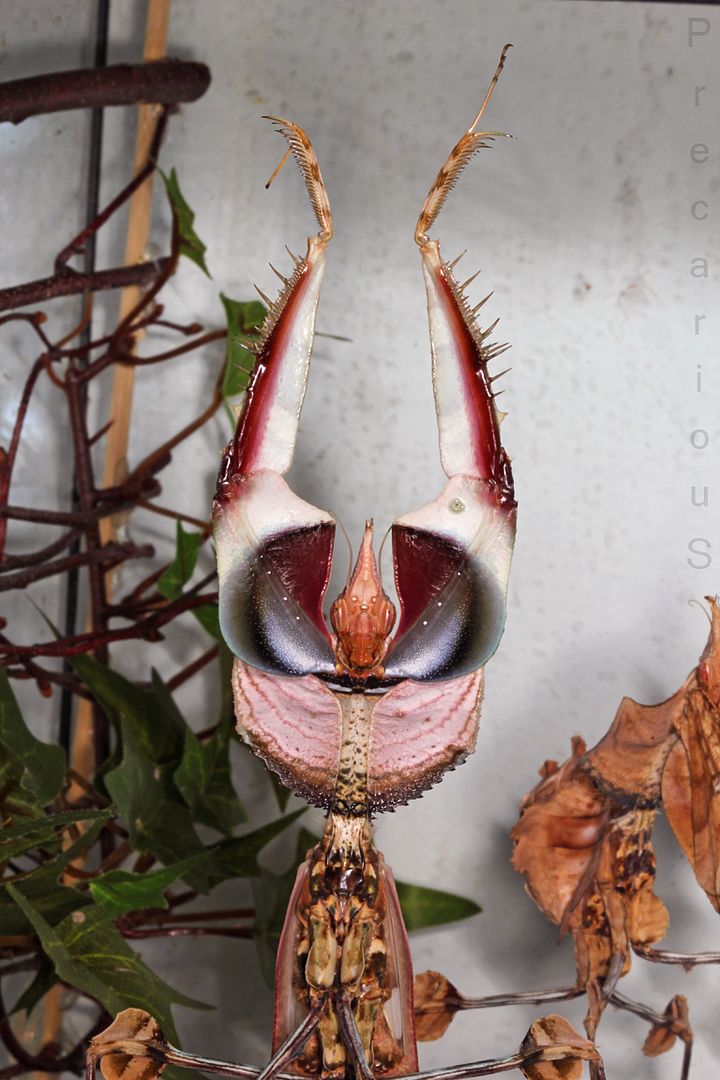
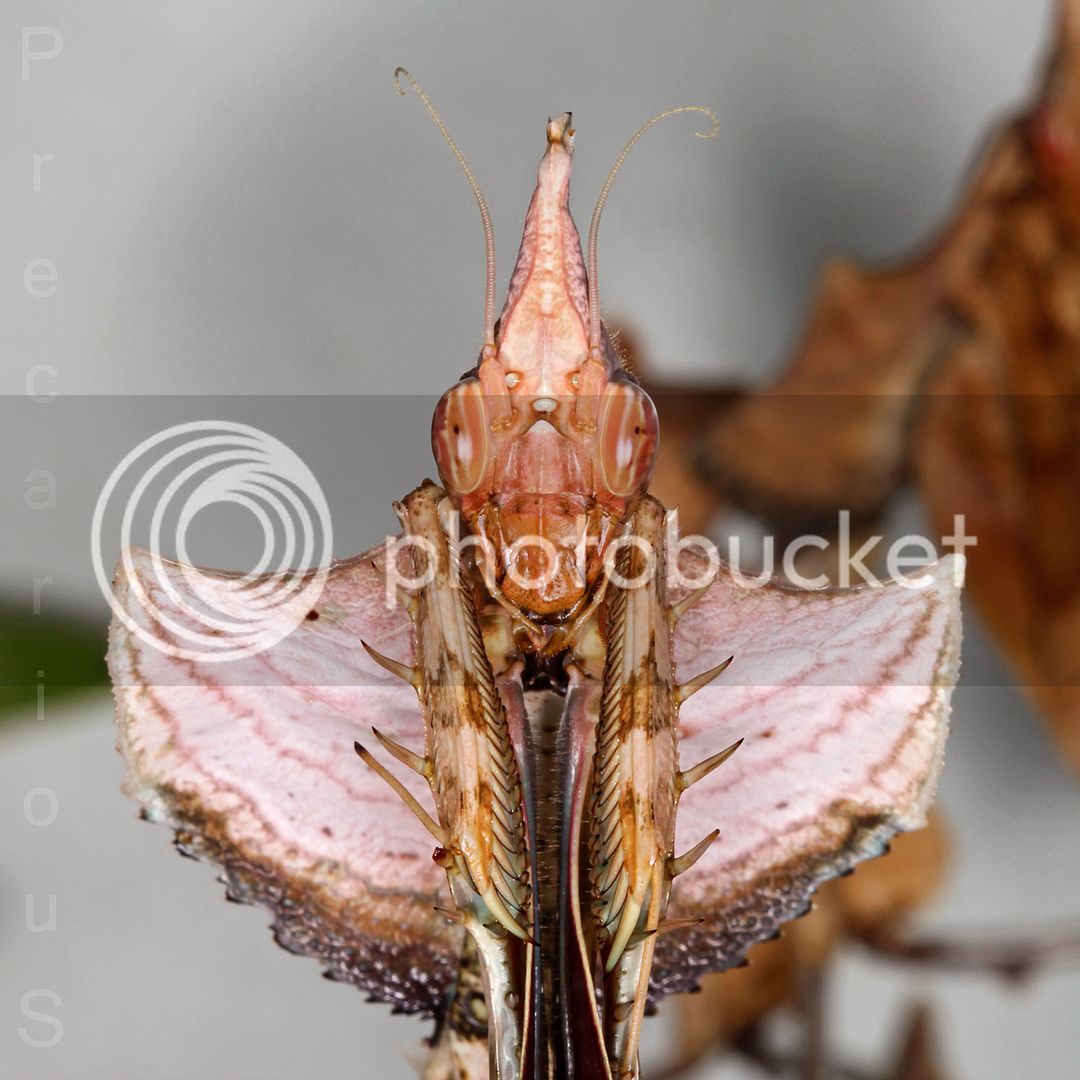
Whereas this female had a deeper purple than average...
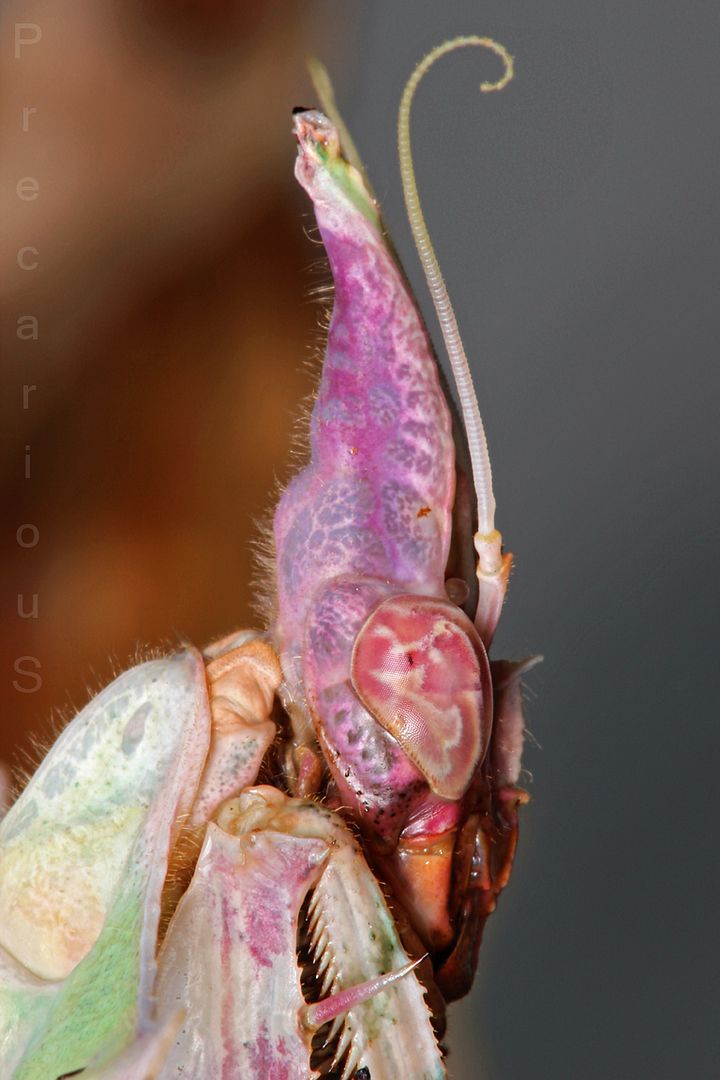
You also have to consider the difference lighting and post processing makes in photography. Adjusting one slider can change the colors in an unnatural way if you're not careful.
However, there are 2 regional species in culture. One is smaller than the other with slightly different coloration. I always get mixed up as to which is from which area so I won't embarrass myself.
This is a male of the smaller of the two...
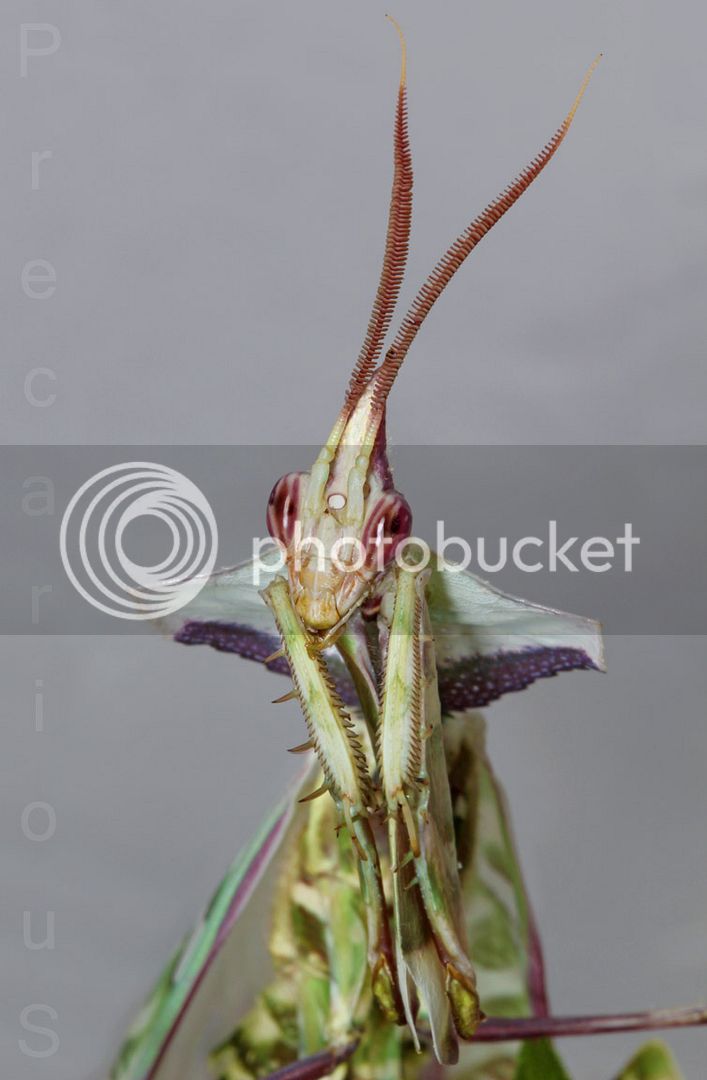
And this is the more commonly available, larger regional species...
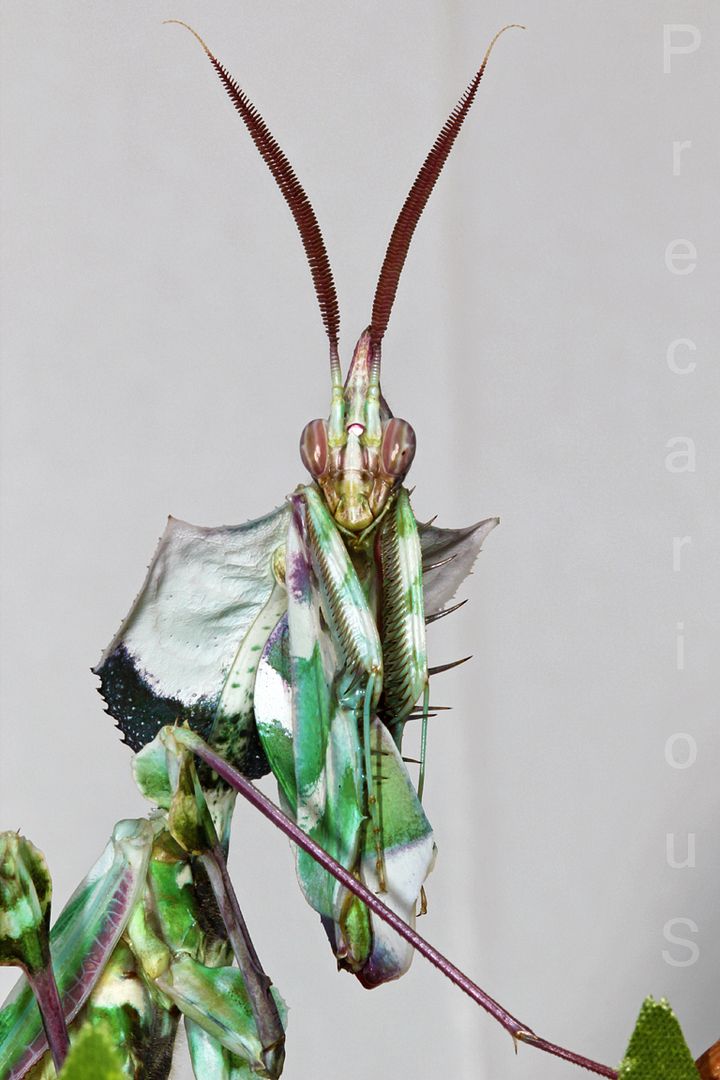
As you can see the difference is very noticeable. The smaller species is much more delicate, has a lot more yellow and light green, redder eyes and light colored face. The bottom of the chest shield is purple versus the very dark bluish-green of the other.
I have never raised the smaller subspecies but received that adult male from a friend, so it could very well be you are spotting the differences between the regional species. But it could also just as easily be natural variation in the more common larger regional species. You'd really have to see those nymphs as adults to know for sure.
LLCoolJew
Well-known member
I didn't want to post here, and change the current topic/discussion, but I just added some info + photos under "Housing and Enclosures" about how to use weather stripping as a great way to secure sticks/branches for Idolos.
Carry on.
Carry on.
guapoalto049
Well-known member
Yes, this has been mentioned in a few posts before. The stock from Tanzania is typically larger (the ones you see in the 11-12 cm range) with less fantastic coloration, while the stocks from Kenya are smaller (9-10 cm) and have more vivid purples and greens.
angelofdeathzz
Well-known member
Thanks for reinforcing what I thought to be true as well, do you keep any from Kenya?Yes, this has been mentioned in a few posts before. The stock from Tanzania is typically larger (the ones you see in the 11-12 cm range) with less fantastic coloration, while the stocks from Kenya are smaller (9-10 cm) and have more vivid purples and greens.

$49.99 ($0.25 / Ounce)
TC INSECTS . 1000+ XS Red Runner Live Roaches Food for Dart Frogs Praying Mantis Spiders Small Lizard Tropical Fish (1/16-1/4 in)
TC INSECTS

$29.99 ($0.15 / Ounce)
TC INSECTS . 200+ XS Red Runner Live Roaches Food for Dart Frogs Praying Mantis Spiders Small Lizard Tropical Fish (1/16-1/4 in)
TC INSECTS

$39.95 ($1.25 / Ounce)
Creation Cultivated 32oz Fruit Fly Culture - Live Feeder Insects for Praying Mantis, Jumping Spiders, Geckos, Lizards, Dart Frogs (Drosophila Hydei Flightless)
Creation Cultivated

$15.99
$19.99
RESTCLOUD Insect and Butterfly Habitat Cage Terrarium Pop-up 23.6 Inches Tall
Restcloud

$14.99 ($0.47 / Ounce)
Fresh Fruit Fly Culture (Drosophila Hydei) - Praying Mantis Mantid Frog Lizard Food - 32oz Cup
Surmen Legacy

$12.99 ($0.03 / Count)
Predator Foods Bulk Live Mealworms - 500 Count (Medium - 0.5")
Predator Foods
Precarious
Well-known member
I've been looking for some kind of grid made of natural fiber. Where do you get it? I've looked at hardware (carpet/tile department) and craft stores.for the gripping surface at the top of the cage i use a hemp grid (1 inch grid) with birch twigs weaved into it. do you guys think hemp is a good gripping/moulting surface?
It's funny because I've also heard the smaller species was more vivid but the specimen I had definitely wasn't. The colors were a little more faded. Just more yellow and lighter in general.Yes, this has been mentioned in a few posts before. The stock from Tanzania is typically larger (the ones you see in the 11-12 cm range) with less fantastic coloration, while the stocks from Kenya are smaller (9-10 cm) and have more vivid purples and greens.
See for yourself...
Kenyan
Granted, much better lighting in the second video but you can still see the Tanzanian's colors are more vivid. The Kenyan was kind of drab which is why I didn't bother making a really well lit video documenting it. Maybe I just had a drab specimen.
guapoalto049
Well-known member
Could be a different stock from Kenya, or like you said an oddball. There are four stocks in culture from what I've heard, but I was referring to IGM 167 Musoma stock and 130 Kenya.
I know I have had some 'vibrance variants' in other species, such as the Rhombodera stalii. People often say they are a leafier green compared to the true R. basalis, and they almost always are, but I have had individuals with much more of a blue-green than others.
That's great you had an opportunity to work with two stocks, did you mix them at all?
I know I have had some 'vibrance variants' in other species, such as the Rhombodera stalii. People often say they are a leafier green compared to the true R. basalis, and they almost always are, but I have had individuals with much more of a blue-green than others.
That's great you had an opportunity to work with two stocks, did you mix them at all?
Precarious
Well-known member
So you rolled your own hemp. :huh: I see...i had to make the grid my self. i will try to get some pics.
The Kenyan was sent to mate my Tanzanian females but he never showed any interest. Makes me wonder if they were even compatible. There is quite a bit of difference.That's great you had an opportunity to work with two stocks, did you mix them at all?
guapoalto049
Well-known member
Hmm are we seeing evolution at work?!The Kenyan was sent to mate my Tanzanian females but he never showed any interest. Makes me wonder if they were even compatible. There is quite a bit of difference.
haha no! i just made the grid part by weaving the hemp into a loose weave. this makes me think there are sub species of idolos. do you think that is possible?So you rolled your own hemp. :huh: I see...
The Kenyan was sent to mate my Tanzanian females but he never showed any interest. Makes me wonder if they were even compatible. There is quite a bit of difference.
frogparty
Well-known member
sub species can will and often do interbreed where ranges overlap. It could be that they are distinctly different yet closely related species, and the pheromone signals do not work between.
Since they are so similar in appearance, if they ARE distinct species then it is a fairly recent divergence evolutionarily speaking, most likely caused by some type of physical barrier between range overlap.
Since they are so similar in appearance, if they ARE distinct species then it is a fairly recent divergence evolutionarily speaking, most likely caused by some type of physical barrier between range overlap.
Precarious
Well-known member
That's a whole other thread. :lol:Hmm are we seeing evolution at work?!
I'm am not a creationist but regional differences are a far cry from the process of metamorphosis developing randomly. Makes about as much sense to me as a god making them all in a day! The truth is usually somewhere in the middle. Seems to be an organized process driving evolution to me. Not 'God' per se, but maybe some type of morphogenic intelligence? OK, I'll shut up now.
http://en.wikipedia.org/wiki/Gaia_hypothesis
http://en.wikipedia.org/wiki/Morphogenetic_field
Precarious
Well-known member
this makes me think there are sub species of idolos. do you think that is possible?
Yeah, apparently there are regional species. Not sure if they can interbreed. Asking the same question with these Rhombodra cf valida. We'll have to see if my buddy's female produced a viable ooth. Sometimes Rhombodera can look identical to the untrained eye but still be incompatible due to regional changes of the genitalia. Again, much more qualified people here to answer these questions so...sub species can will and often do interbreed where ranges overlap. It could be that they are distinctly different yet closely related species, and the pheromone signals do not work between.
Since they are so similar in appearance, if they ARE distinct species then it is a fairly recent divergence evolutionarily speaking, most likely caused by some type of physical barrier between range overlap.
LLCoolJew
Well-known member
Idolo Mismolt: Good morning. Just woke up to one of my two L6 females on the ground of the terrarium after a mismolt that took one of her rear legs.  She's still alive (for how long, I don't know!)... But I'm wondering what I could have done to have achieved a more successful molt. You guys talk about grids and nets, and I wonder if I missed the memo on that one in my set up. Thanks! -LL
She's still alive (for how long, I don't know!)... But I'm wondering what I could have done to have achieved a more successful molt. You guys talk about grids and nets, and I wonder if I missed the memo on that one in my set up. Thanks! -LL
Last edited by a moderator:
Precarious
Well-known member
Sorry to hear that. Can we see a photo of your enclosure to better suggest how to improve it?Idolo Mismolt: Good morning. Just woke up to one of my two L6 females on the ground of the terrarium after a mismolt that took one of her rear legs.She's still alive (for how long, I don't know!)... But I'm wondering what I could have done to have achieved a more successful molt. You guys talk about grids and nets, and I wonder if I missed the memo on that one in my set up. Thanks! -LL
LLCoolJew
Well-known member
Yup! This is the one!
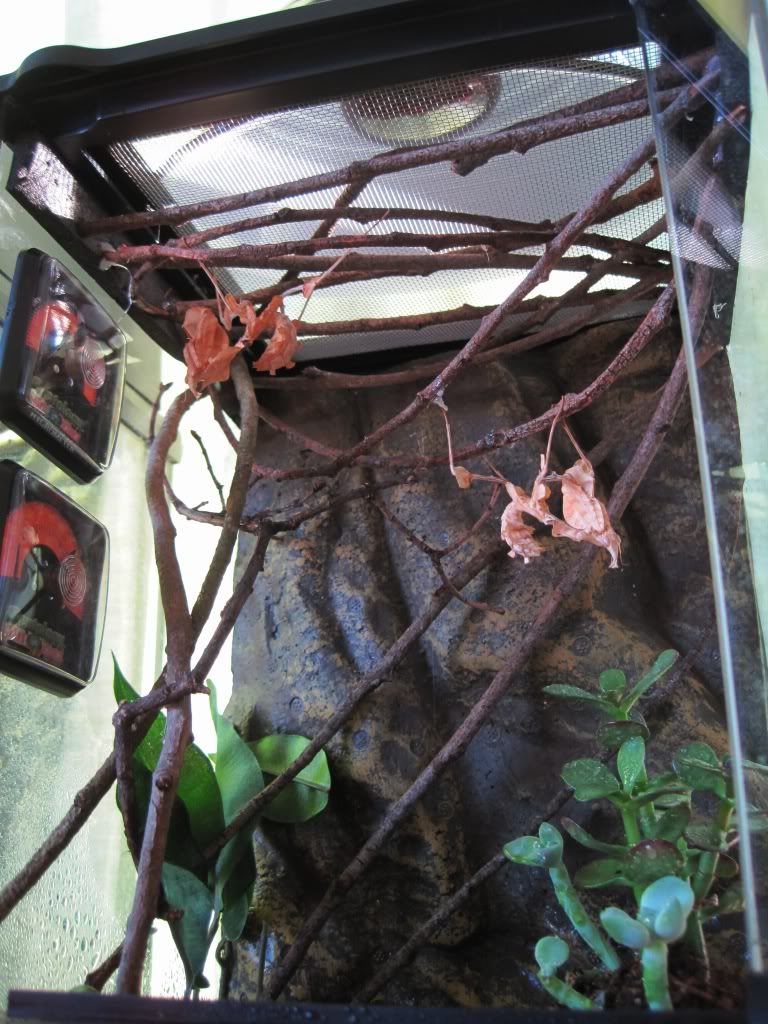

guapoalto049
Well-known member
I've found that metal screens are not a good surface for mantids to molt from, especially delicate ones. Something like Sporeworld suggested is good as a base, or do the entire roof of rough sticks.




























